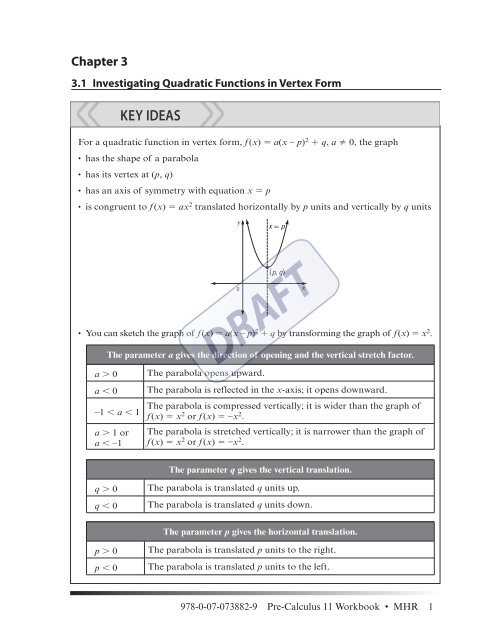Pre-Calculus 11 Workbook - McGraw-Hill Ryerson
Pre-Calculus 11 Workbook - McGraw-Hill Ryerson
Pre-Calculus 11 Workbook - McGraw-Hill Ryerson
- No tags were found...
You also want an ePaper? Increase the reach of your titles
YUMPU automatically turns print PDFs into web optimized ePapers that Google loves.
Chapter 33.1 Investigating Quadratic Functions in Vertex FormKEY IDEASFor a quadratic function in vertex form, f (x) = a(x – p) 2 + q, a ≠ 0, the graph• has the shape of a parabola• has its vertex at (p, q)• has an axis of symmetry with equation x = p• is congruent to f (x) = ax 2 translated horizontally by p units and vertically by q unitsyx = p( p, q )0 x• You can sketch the graph of f (x) = a(x – p) 2 + q by transforming the graph of f (x) = x 2 .The parameter a gives the direction of opening and the vertical stretch factor.a > 0a < 0–1 < a < 1a > 1 ora < –1The parabola opens upward.The parabola is reflected in the x-axis; it opens downward.The parabola is compressed vertically; it is wider than the graph off (x) = x 2 or f (x) = –x 2 .The parabola is stretched vertically; it is narrower than the graph off (x) = x 2 or f (x) = –x 2 .The parameter q gives the vertical translation.q > 0q < 0The parabola is translated q units up.The parabola is translated q units down.The parameter p gives the horizontal translation.p > 0p < 0The parabola is translated p units to the right.The parabola is translated p units to the left.978-0-07-073882-9 <strong>Pre</strong>-<strong>Calculus</strong> <strong>11</strong> <strong>Workbook</strong> • MHR 1

















